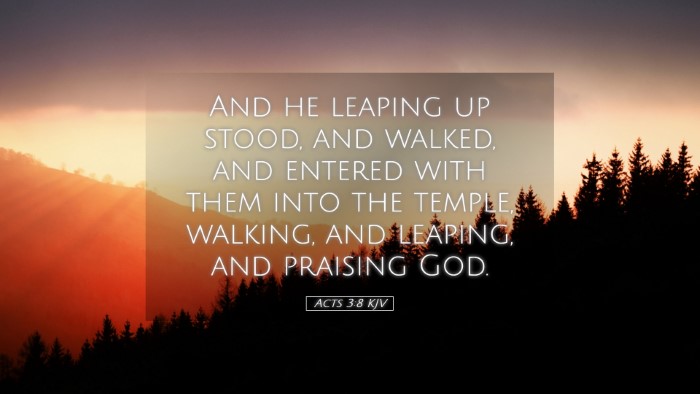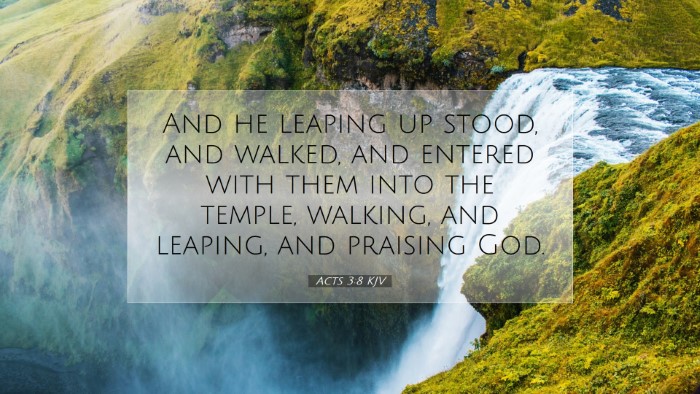Old Testament
Genesis Exodus Leviticus Numbers Deuteronomy Joshua Judges Ruth 1 Samuel 2 Samuel 1 Kings 2 Kings 1 Chronicles 2 Chronicles Ezra Nehemiah Esther Job Psalms Proverbs Ecclesiastes Song of Solomon Isaiah Jeremiah Lamentations Ezekiel Daniel Hosea Joel Amos Obadiah Jonah Micah Nahum Habakkuk Zephaniah Haggai Zechariah MalachiActs 3:8
Acts 3:8 KJV
And he leaping up stood, and walked, and entered with them into the temple, walking, and leaping, and praising God.
Acts 3:8 Bible Commentary
Commentary on Acts 3:8
Verse Text: “And leaping up, he stood and walked, and entered with them into the temple, walking, and leaping, and praising God.”
Introduction
The healing of the lame man at the Beautiful Gate is a remarkable event in the early Church, showcasing the power of God through the apostles and emphasizing the theme of restoration and praise. Acts 3:8 marks a pivotal moment not only for the individual healed but also for the burgeoning Christian community. This commentary synthesizes insights from Matthew Henry, Albert Barnes, and Adam Clarke to provide a deeper understanding of this significant miracle.
Contextual Background
In Acts 3, Peter and John are on their way to the temple for prayer when they encounter a man lame from birth, begging at the gate. This event serves as a backdrop for the unfolding of the early Church's mission. Understanding the socio-historical context is crucial; the Jewish temple was a place of worship, prayer, and community, making it an ideal setting for a miracle that would gather attention.
Verse Analysis
1. The Action of the Lame Man
The phrase "leaping up" (Acts 3:8) signifies not just physical healing but a complete transformation. According to Albert Barnes, this action demonstrates a restoration to full health, symbolizing the new life that Jesus brings. The man does not simply rise; he leaps—an act of joy and exuberance indicative of his newfound strength.
2. The Significance of Walking
“He stood and walked” signifies movement and begins a journey both physically and spiritually. Matthew Henry emphasizes that walking represents the man's new life in Christ, indicating a departure from his previous state of dependence and isolation. This new ability to walk is not merely a restoration of function but also a step into a community among God’s people.
3. Entrance into the Temple
The man’s willingness to enter the temple with Peter and John demonstrates an immediate response to grace. Adam Clarke notes that by entering the temple, he publicly acknowledges the healing and the power of God. His entrance symbolizes the uniting of the marginalized with the worshiping community, emphasizing inclusivity in the growing body of believers.
4. Walking, Leaping, and Praising God
The triadic phrase “walking, and leaping, and praising God” embodies the holistic response to his healing. Each action signifies a layer of his experience: walking relates to his new life, leaping signifies joy, and praising God is an acknowledgment of the divine source of his transformation. Matthew Henry highlights that genuine praise naturally follows an encounter with God’s grace.
Theological Implications
This pericope encapsulates several theological themes relevant to both ancient and modern audiences:
- Divine Power: The miracle underscores the power of God at work through the apostles. It reaffirms the promise of Jesus that believers would perform great works through faith.
- Faith and Response: The man's response demonstrates the proper attitude of gratitude and recognition of God’s sovereignty in healing. This serves as an instructive example for believers today.
- Community and Fellowship: The man’s integration into the worshiping community highlights the importance of welcoming all into the fellowship of believers, reinforcing the inclusive nature of the Gospel.
- Joy as a Response to Salvation: The exuberance of the healed man reflects the joy which accompanies deliverance and spiritual awakening, encouraging believers to express their thankfulness and vivacity in worship.
Practical Applications
For pastors, theologians, and students, this passage invites several practical reflections:
- Emphasis on Prayer: Just as Peter and John were on their way to pray, the importance of prayer in seeking God’s guidance and power is paramount for ministry.
- Faith in Action: Believers are called to take action in their faith, looking for opportunities to reach out and assist those in need—both spiritually and physically.
- Encouragement of Praise: This passage challenges the community to foster an environment where praising God is encouraged, as a natural outflow of experiencing His goodness.
- Addressing Physical and Spiritual Needs: The Church must balance its role in addressing both the physical needs (as seen in healing) and spiritual needs (as seen in preaching the Gospel).
Conclusion
Acts 3:8 serves as a transformative moment in the life of the early Church and offers profound insights into the nature of healing, community, and worship. The combined reflections from Matthew Henry, Albert Barnes, and Adam Clarke emphasize the miracle's rich layers of meaning and its significance for contemporary believers. As we reflect on this passage, may we be inspired to leap into our callings, walk in faith, and continually praise the God who restores and redeems.


